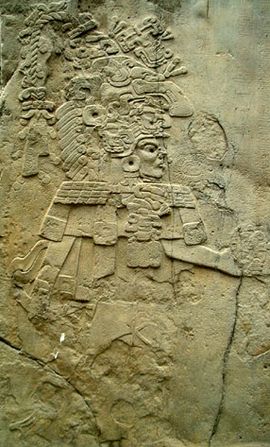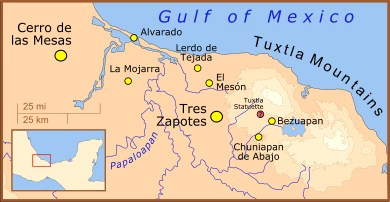Epi-Olmec culture facts for kids
The Epi-Olmec culture was an ancient civilization. It lived in the central part of what is now the Veracruz state in Mexico. This culture existed from about 300 BCE to 250 CE. It was located mainly around the Papaloapan River.
The Epi-Olmec culture came after the famous Olmec civilization. That's why it's called "Epi-Olmec," meaning "after Olmec." Even though the Epi-Olmec people didn't spread as far as the Olmecs, they made amazing progress. They developed a very advanced calendar and their own writing system. These were things the earlier Olmecs didn't have.
The biggest Epi-Olmec cities were Tres Zapotes and later Cerro de las Mesas. However, these cities never became as large or important as the great Olmec cities before them, or El Tajín which came later. Other important Epi-Olmec places included El Mesón, Lerdo de Tejada, La Mojarra, Bezuapan, and Chuniapan de Abajo.
Contents
How the Culture Changed

The Epi-Olmec culture grew as the eastern part of the Olmec lands became less populated. The Olmec culture itself was also declining. The Epi-Olmec culture wasn't a sudden new start. Instead, it was a slow change from the Olmec way of life. Many Olmec art styles and ideas were still used by the Epi-Olmec people.
For example, Tres Zapotes, which was a large Olmec city, continued to be an important center for the Epi-Olmec culture. Daily life for most people stayed much the same. They farmed to get food and also hunted and fished. Their homes were made of wattle-and-daub (a mix of sticks and mud) with thatched roofs. They also used bell-shaped pits to store their food.
During this time, trade between different regions in Mesoamerica generally decreased. People also used fewer fancy items from far away, like greenstone beads. It's thought that local luxury goods, such as cotton cloth and tall headdresses, became the new status symbols. However, trade didn't stop everywhere. For instance, there was more interaction with cultures across the Isthmus of Tehuantepec. Also, more obsidian (a volcanic glass) was brought in.
Epi-Olmec art was different from earlier Olmec art. It often had less detail and wasn't as finely made. Ceramic figures were less realistic. The large stone monuments and stelae (carved stone slabs) at Tres Zapotes didn't show the same skill as the older Olmec works from San Lorenzo and La Venta.
The way the Epi-Olmec leaders ruled also seemed different. At Tres Zapotes, the large mounds and sculptures were spread out. This suggests that power was less centralized than with the Olmecs. Perhaps a group of leaders shared power instead of one single ruler.
Epi-Olmec Art and Writing
Writing and Calendars
Olmec sculptures often showed portraits of rulers, like the 17 huge Olmec colossal heads. But Epi-Olmec monuments started to focus more on historical events. This led to the creation of sculptures with dates and writing.
These dated writings were possible because the Epi-Olmec culture used the Mesoamerican Long Count calendar very early. They also had their own writing system, called the Epi-Olmec or Isthmian script. This script can be seen on several Epi-Olmec sculptures. Examples include La Mojarra Stela 1, the Tuxtla Statuette, and Tres Zapotes Stela C. Each of these also has a very early Long Count date. These Epi-Olmec texts were the most detailed writings of their time in Mesoamerica.
Both the Isthmian script and the Long Count calendar were used by other cultures too. But their combined use is a special feature of the Epi-Olmec culture.
What the Art Shows
In contrast to monuments from Izapa (about 330 miles southeast), which showed myths and religious stories, Epi-Olmec monuments celebrated their rulers. For example, La Mojarra Stela 1 shows a ruler wearing fancy clothes and a tall headdress. Experts believe the writing on it names the figure "Harvester Mountain Lord." The script tells about his rise to power, wars, a solar eclipse, his own bloodletting (a ritual), and a "dripping sacrifice." This sacrifice might have been of his brother-in-law.
Other Epi-Olmec monuments show similar finely dressed figures with tall, flowing headdresses. These include the Alvarado Stela and El Mesón Stela 1. Unlike La Mojarra Stela 1, these two monuments also show a smaller, possibly scared, figure below the main ruler. Some worn-out Isthmian script glyphs might be on the Alvarado Stela. El Mesón Stela 1 has no writing.
This type of art, which praised rulers, later became common in the Maya lands to the east during the Classic era.
The End of the Epi-Olmec Culture
By 250 CE, other sites further north along the Veracruz coast became more important. These included Cerro de las Mesas and Remojadas. Although Tres Zapotes continued to exist into the Classic era, its most important time had passed. The Epi-Olmec culture slowly changed into the Classic Veracruz culture.
See also
 In Spanish: Cultura epiolmeca para niños
In Spanish: Cultura epiolmeca para niños


